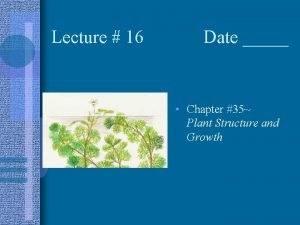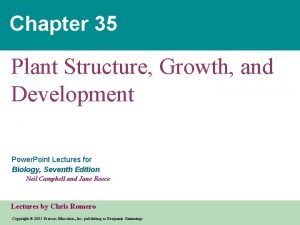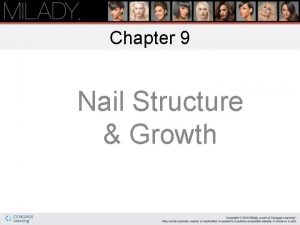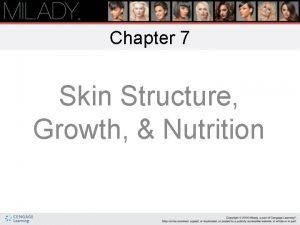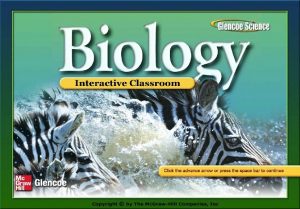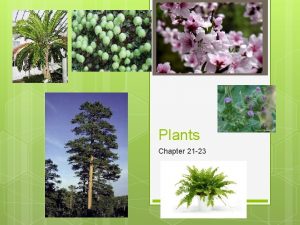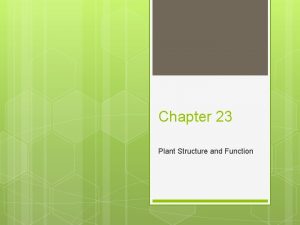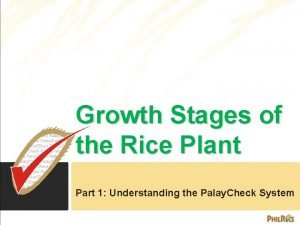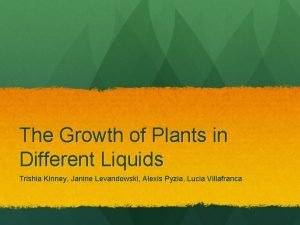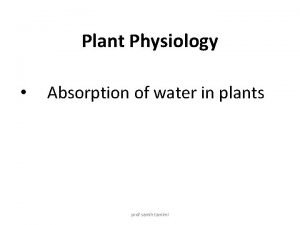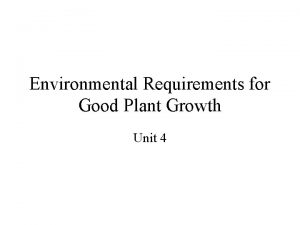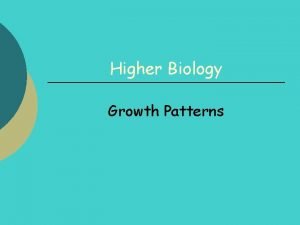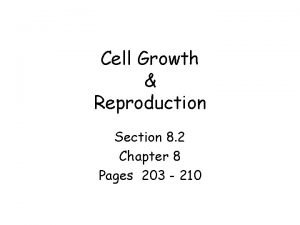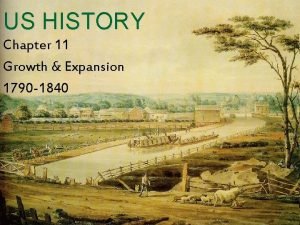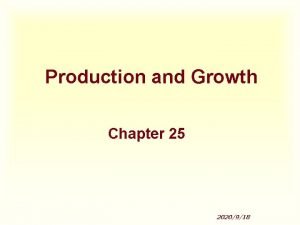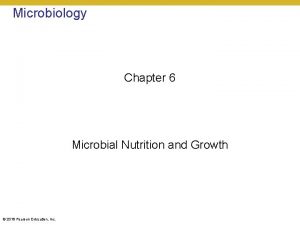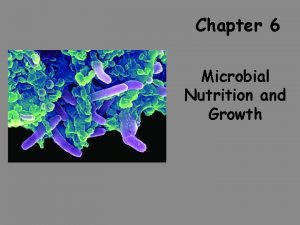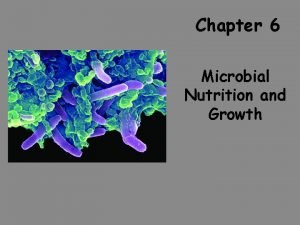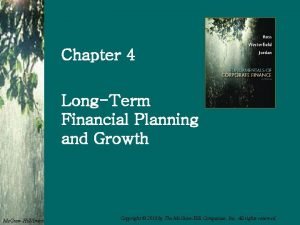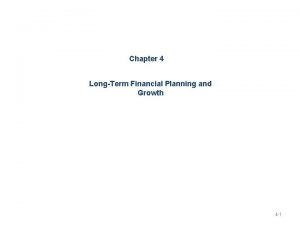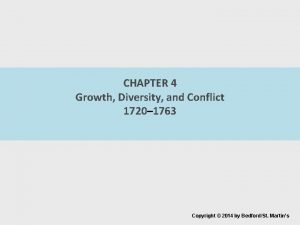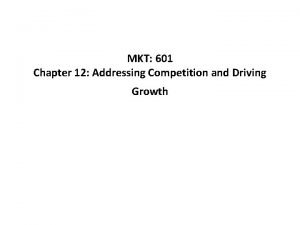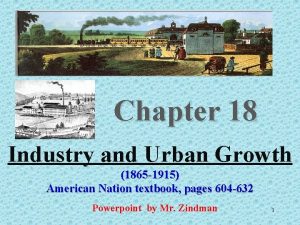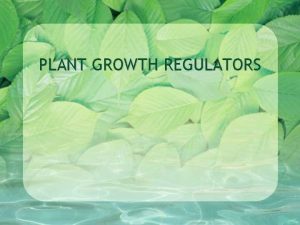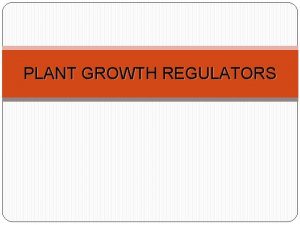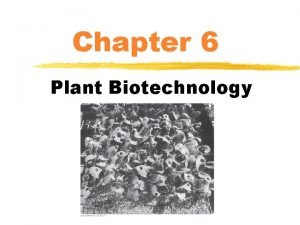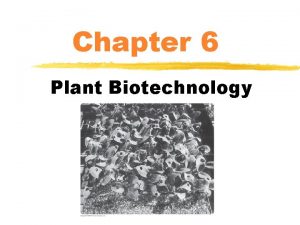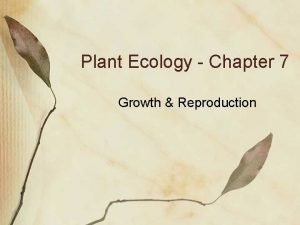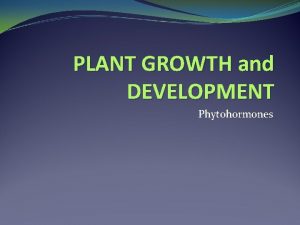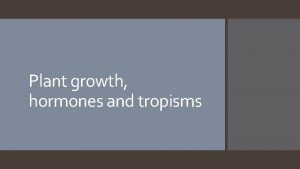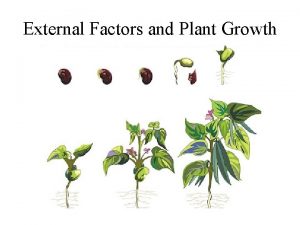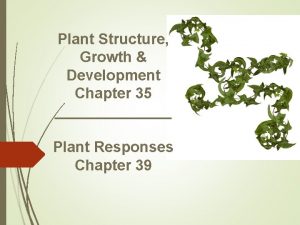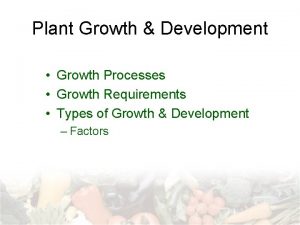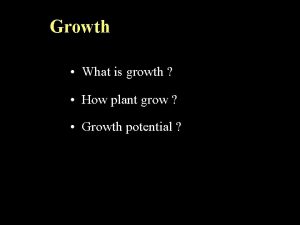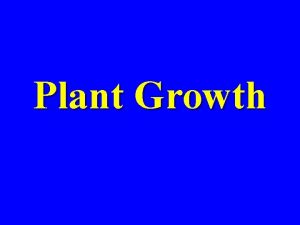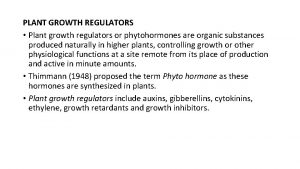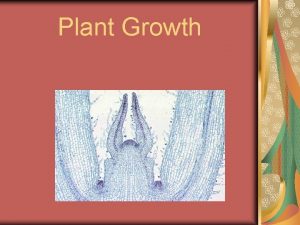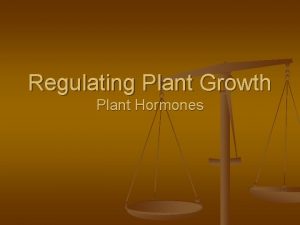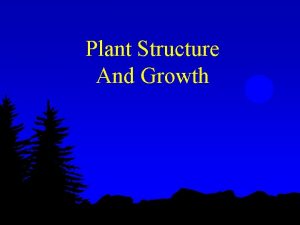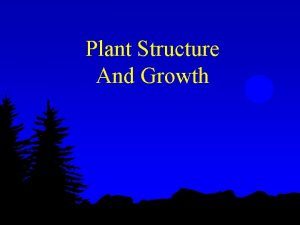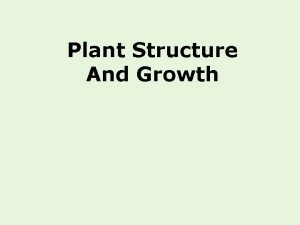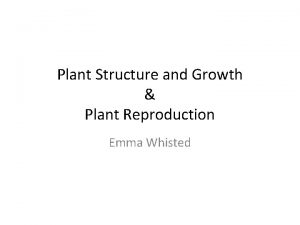Plant Structure and Growth Chapter 35 I Plant










































- Slides: 42

Plant Structure and Growth Chapter 35

I) Plant Body A) controlled by 1) genes: they determine what structures will form 2) Environment: can alter gene expression depending on what is needed

B) Basic Organs 1) Roots: * anchor * absorb minerals and water

a) fibrous roots: a 1) found on monocots a 2) spread out right under soil * good coverage for absorption * helps hold soil in place

b) Tapoot: Found on most dicots b 1) long with branches for absorption b 2) good anchor b 3) stores food

c) adventitious roots c 1) roots that come from leaves or stem * help support plant

2) The shoot system: stems and leaves a) Stem: a 1) supports leaves at nodes * axillary bud: site on node where a branch can form

a 2) terminal bud: top of stem where growth for height occurs * this inhibits growth at axillary buds(apical dominance). If removed more branches will form

b) leaves: main site of photosynthesis b 1) blade = leaf b 2) petiole: attaches blade to stem

b 3) monocot leaves: veins run parallel b 4) dicot leaves: veins are branched

C) Plant Tissues: dermal, vascular, and ground 1) dermal(epidermis): layer of cells that protects the plant a) cells will have different structure depending on what it is covering a 1) ex: cuticle/waxy covering

2) Vascular tissue: transports material through plant a) xylem: carry water and minerals a 1) tracheids * long, tapered, with pits for water transfer

a 2) vessel elements: short, wide, perforated ends * water flows directly from one to another * string together to form vessels

b) Phloem: carry sugar and minerals b 1) cells called sieve-tube members(stm’s) * holes at end of tubes form sieve plate * alive, but don’t have nucleus, ribosomes, etc.

b 2) companion cell: live attached to stm’s * connected to stm’s by plasmodesmata (specialized openings between cells) * provide proteins to stm’s

3) Ground tissue a)all other tissue not vascular or epidermal a 1) dicot stem: pith is inside of the vascular tissue, cortex is outside of it.

D) Tissues made up of three cell types 1) Parenchyma: Have thin, flexible primary walls, no secondary walls. a) do most metabolism of the plant a 1) photosynthesis, starch storage

2) Collenchyma: thicker primary walls, they help support young parts of the plant. a) continue to elongate as the plant grows.

3) Sclerenchyma: Thick primary and secondary walls. Secondary wall has lignin for extra strength.

a) dead at maturity, but formed as a helix so they stretch as the plant grows

II) Plant Growth * annuals: complete life cycle in one year then die * biennial: two years * perennial: grows year after year, completing many flowering cycles

A) Meristems 1) embryonic tissue where growth can occur

a) apical meristem a 1) tips of buds and roots for elongation * elongation is called primary growth

b) lateral meristem: tissue inside the stems and roots of a woody plant that makes the plant thicker. b 1) vascular cambium adds xylem and phloem b 2) cork cambium adds cork

B) Root Growth 1) root cap a) protects root as it pushes through soil a 1) secretes a polysaccharide that helps it slide through the soil

2) Zone of Cell Division a 1) high concentration of mitotically dividing cells a 2) quiescenter – resistant to damage to replace apical meristem if damaged

a 3) procambium forms vascular tissue a 4) protoderm turns into dermis a 5) ground meristem forms ground tissue

3) Zone of Elongation a) cells elongate to push the root down through the soil

4) Zone of maturation a) area of final differnetiation

5) Stele – tube of xylem and phloem running through center of root a) pericycle: outermost cells that can create a lateral root

6) cortex: starch storage

7) Endodermis: ring of cells between the stele and the cortex a) casparian strip: ring of fat around each cell that forces water through the cells to the stele so water cant leak back to the cortex

C) Stems 1) vascular bundles: groupings of xylem and phloem that run the length of the stem.

D) Leaves 1) Stomata: opening in the leaf for gas exchange 2) opening is controlled by guard cells

3) mesophyll a) all tissue in between upper and lower epidermis

b) palisade payer: main layer of photosynthesis c) spongy mesophyll: cells surrounding veins inleaf and stomata. Have air spaces between them.

III) Secondary growth A) Stems 1) Vascular cambium a) produce xylem and phloem in woody plants a 1) phloem to the outside, xylem to the inside

a 2) annual rings * xylem grows larger in spring/summer than fall/winter *Vascular growth animation

2) Cork cambium a) replaces/thickens epidermis a 1) outermost layer is cork, with suberin added a 2) inner layer is phelloderm a 3) together they are called periderm

3) Bark: layers of cork, cork cambium, and living phloem

4) sapwood a) active xylem

5) heartwood a) dead xylem used for support *plant growth review
 Chapter 35 plant structure growth and development
Chapter 35 plant structure growth and development Vascular ray
Vascular ray Apical meristem
Apical meristem Plant growth index
Plant growth index Shoot system
Shoot system Primary growth and secondary growth in plants
Primary growth and secondary growth in plants Milady nail structure and growth
Milady nail structure and growth Tissue bordering the root and sides of fingernail
Tissue bordering the root and sides of fingernail Chapter 7 skin structure growth and nutrition
Chapter 7 skin structure growth and nutrition Step growth polymerization vs chain growth
Step growth polymerization vs chain growth Geometric growth graph
Geometric growth graph Neoclassical growth theory vs. endogenous growth theory
Neoclassical growth theory vs. endogenous growth theory Difference between organic and inorganic growth
Difference between organic and inorganic growth Enumerate the rice plant growth and development stages
Enumerate the rice plant growth and development stages Functions of ethylene
Functions of ethylene Chapter 22 plant structure and function answer key
Chapter 22 plant structure and function answer key Chapter 21 plant structure and function
Chapter 21 plant structure and function Section 23-4 leaves
Section 23-4 leaves Sri system of rice intensification
Sri system of rice intensification Plant growth with different liquids
Plant growth with different liquids Significance of transpiration
Significance of transpiration Observation of plant growth day by day
Observation of plant growth day by day Environmental requirements for good plant growth
Environmental requirements for good plant growth What is growth in biology
What is growth in biology Tronsmo plant pathology and plant diseases download
Tronsmo plant pathology and plant diseases download Tronsmo plant pathology and plant diseases download
Tronsmo plant pathology and plant diseases download Albugo eye
Albugo eye Quantity theory of money economics
Quantity theory of money economics Copyright
Copyright Chapter 8 cell growth and division section 8-2 answer key
Chapter 8 cell growth and division section 8-2 answer key Chapter 11 growth and expansion
Chapter 11 growth and expansion Chapter 25 production and growth
Chapter 25 production and growth Chapter 6 microbial nutrition and growth
Chapter 6 microbial nutrition and growth Chapter 6 microbial nutrition and growth
Chapter 6 microbial nutrition and growth Pour plate vs streak plate
Pour plate vs streak plate Long term financial planning and growth chapter 4
Long term financial planning and growth chapter 4 Sustainable growth rate
Sustainable growth rate Growth diversity and conflict chapter 4
Growth diversity and conflict chapter 4 Chapter 4 growth diversity and conflict
Chapter 4 growth diversity and conflict Chapter 12 addressing competition and driving growth
Chapter 12 addressing competition and driving growth Chapter 7 human growth and development
Chapter 7 human growth and development Chapter 11 growth and expansion vocabulary
Chapter 11 growth and expansion vocabulary Chapter 18 industry and urban growth
Chapter 18 industry and urban growth
